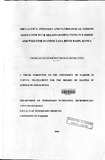| dc.description.abstract | Fish have become major source of protein and essential fatty acids for many
Kenyans. Thus, many farmers are venturing into fish farming but have challenges
due to fish diseases and parasites. This study examined the prevalence, intensity
and pathological lesions associated with helminth infections in market, farmed and
wild fish in upper Tana River basin, Kenya.
A total of 280 market and field (farmed and wild) fish were examined between
2007 and 2008 to determine occurrence and pathology of helminth infections.
Forty three fish were obtained from the market while 237 (148 farmed and 89
wild) were from the field. Nile tilapia (Oreochromis nilotica), catfish (Clarias
gariepinus) and other fish species were obtained from Gikomba fish market,
Nairobi while farmed and wild tilapia and catfish were from Sagana fish breeding
farm, Kirinyaga district and River Tana, respectively. Post-mortem examination
was undertaken on the fish, lesions recorded, parasites and tissues collected for
histology. Recovered parasites were preserved in 70 % alcohol while tissue
sections were fixed in 10 % neutral formalin, processed, stained and examined for
microscopic lesions.
Eight genera of helminth were recovered from tilapia and catfish in the field study
and had variable prevalences. The prevalence were Diplostomum spp. – 35.4 %,
Contracaecum spp. - 33.8 %, Paracamallanus spp. - 24.1 %, Acanthocephalus
spp. - 13.9 %, Neascus spp. – 9.7 %, Clinostomum spp. – 8.0 %, Proteocephalus
spp. – 2.5 % and Caryophyllaeidea spp. – 0.4 %. In the market survey, Contracaecum spp. were recovered at a prevalence of 30.3 % in tilapia and catfish, respectively. Digenean metacercariae were the most prevalent helminth among the field fish, with Neascus and Clinostomum spp. being recovered from tilapia. Contracaecum spp. prevalence in market tilapia and catfish was markedly higher than in farmed and wild fish at 20 % and 91 %, respectively. There were significant differences in Contracaecum spp. infection between tilapia and catfish and between farmed and wild fish of both fish species (p < 0.05).
In the market study, Contracaecum spp. worm load ranged from 1 – 593, with a
mean intensity of 169 worms per fish, while in the field study fish, counts ranged
from 1 – 846 worms and a mean intensity of 103.4 worms per fish (p < 0.05) for
the two fish species. The mean Paracamallanus spp. worm count in the field
catfish was 6.1 with a range of 1 – 41. There was a significant difference in
infestation between the farmed and wild catfish (p < 0.05). Diplostomum spp.
mean count was 5.2 with a range of 1 – 26 parasites per fish (p < 0.05) in the two
fish species and between farmed and wild fish species. Clinostomum spp. mean
count in tilapia was 2.4 with a range of 1 – 7 (p < 0.05). There was a significant
difference in this parasite mean count in tilapia between farmed and wild fish (p <
0.05). Acanthocephalus spp. mean count was 5.4 with a range of 1 -27, (p < 0.05).
The mean Proteocephalus spp. count was 2.2, with a range of 1 – 4 parasites per
fish (p < 0.05) for the two fish species. There was a significant difference in
infection between farmed and wild catfish. Caryophyllaeidea spp. mean count was
low.
There were more microscopic than gross lesions observed. Overall, microscopic
lesions in both fish species were observed in the:- stomach – 25.7 %, intestines:-
41.8 %, liver – 38.8 %, gills 22.4 %, spleen - 21.9 %, heart- 6.3 %, skin - 23.2 %,
muscles – 4.6 %, kidneys - 15.6 %, brain- 19.4 %, testis – 1.7 %, ovaries – 1.3 %
and aborescent organ – 0.9 %. Contracaecum spp. in the peritoneum caused
proliferation of fibroblasts, eosinophils, lymphocytes, plasma cells and hetrocytes.
Contracaecum, Paracamallanus, Acanthocephalus, Proteocephalus and
Caryophyllaeidea species caused epithelial desquamation, goblet cell hyperplasia,
exudation into the lumen, villi desquamation, necrosis of columnar epithelium and
infiltration of eosinophils and other mononuclear inflammatory cells into the
lamina propria and muscularis. Other lesions included melanomacrophage
infiltration into skin cysts and liver parasitic cysts, bile duct and hepatic blood
vessels occlusion and pressure atrophy of epithelial and endothelium accompanied
by blood vessel congestion and cholestasis.
In this study the occurrence of Paracamallanus spp. in catfish and Acanthocephalus spp. in tilapia are reported for the first time in the upper river Tana basin in Kenya. Digenean metacercariae were more prevalent than all other helminths, with farmed males and adult fish having higher helminth prevalence than wild, females and the young fish, espectively. Seven types of ectoparasites namely Piscinoodinum, trichodina, Ichthyophthirius, ambyphrya, Lamprolegna and Ichthyobodo species and aquarium mites were recovered in varying prevalences. In conclusion, helminths were found to be more prevalent in fish in the upper river Tana basin and caused pathological lesions in apparently healthy looking tilapia and catfish. More research on the impact of elminthiasis on aquaculture fish production in the River Tana basin is recommended. | en |

